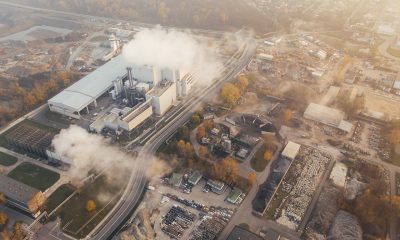Agriculture
Top 5 Vertical Farming Startups Thriving in (2025)

We have come a long way since the first agricultural revolution, which occurred around 10,000 BC, marking the transition from hunting and gathering to settled agriculture.
Over time, irrigation, fertilizers, and crop rotation were introduced to advance the field, which was further transformed by mechanization that significantly increased productivity. Then pesticides, synthetic fertilizers, and selective breeding helped the agricultural world keep pace with the growing population.
But the population is increasing at a fast rate, and feeding a growing number of people as time progresses presents a challenge. Not to mention, critical resources are becoming scarcer. Modern agricultural practices have also been harmful to the planet, leading to a loss of arable land.
In fact, between 2015 and 2019, the world lost at least 100 million hectares of healthy and productive land each year.
Against this backdrop, it is becoming difficult to produce enough food to sustain the global population, all the while preserving the ecosystems. This is where vertical farming comes into the picture.
Vertical Farming: A High-Tech Answer to Modern Agriculture’s Biggest Challenges

A promising agricultural technique, vertical farming involves growing crops in vertically stacked layers, rather than using up land in the traditional horizontal direction. These vertical layers of crops are integrated into structures like shipping containers, rooftops, and warehouses.
This innovative solution allows for more efficient use of space as well as year-round production, no matter the location or weather. On top of that, vertical farming potentially increases yields.
Modern vertical farms leverage advanced technologies like aeroponics, aquaponics, or hydroponics along with LED lighting, sensors, robotics, automation, climate control systems, AI-powered environment monitoring, and data analysis.
Under this method of farming, a delicate balance of water, artificial light, and temperature is maintained to create the most optimal conditions for the crops to grow. As a result, vertical farming enables farmers to produce more food on the same or even less amount of land.
While high-tech, vertical farming isn’t entirely a new concept. The Babylonian Hanging Gardens from about 2,500 years ago are a prominent example. These massive gardens were built on elevated terraces, representing a remarkable feat of engineering.
Then, in the 1600s, we saw French and Dutch farmers refine ways to cultivate fruits not typically suited for their climates. The warmer-climate fruits like peaches were grown in cooler regions by having them against stone walls that absorbed and retained heat, creating their own microclimates.
So, while the concept of vertical farming has existed for centuries, the technology-driven modern iteration has only recently gained momentum as a sustainable solution to urban food production and the growing global population. The model, after all, provides maximum output with limited resources and minimal environmental impact.
Not only does vertical farming cut down water and land usage substantially, but it also produces crop yields many times that of traditional farming. Additionally, the majority of the world’s population lives in urban areas, creating a huge demand for fresh food while having less land for production, and this modern farming offers the perfect solution for that.
Vertical farming can also help eliminate seasonality by allowing consistent and increased year-round production. Moreover, both crops and farmers aren’t exposed to wildlife, environmental hazards, or diseases. Besides aiding in human health, vertical farming can help protect land and its quality.
Top Vertical Farming Startups That Are Still Thriving

Given the many benefits of vertical farming in the face of depleting arable land, limited freshwater resources, environmental pollution, and extreme weather conditions, multiple new indoor-farming companies have come to life in the past decade and attracted a lot of capital from investors.
However, in recent months, many of these companies have either closed down or gone bankrupt as funding dried up. In 2024, the capital raised by these companies fell below $250 million, compared to over $2 billion in 76 deals in 2021. This year, it has fallen further to just five deals totaling $57 million.
A prominent example of this trend is San Francisco-based startup Plenty, which opened in 2023 only to file for Chapter 11 bankruptcy at the end of 2024, citing the rising cost of energy. This was despite raising over a billion dollars from investors like Jeff Bezos and SoftBank and having secured a partnership with Walmart. Its value reportedly plunged from $1.9 billion to under $15 million.
While having shuttered down its California facility that grew leafy greens, Plenty is still running its strawberry production at its vertical farm in Virginia.
Another example is New York-based Bowery Farming, which also halted all operations in late 2024. It was once valued at $2.3 billion. The likes of AppHarvest, Kalera, Growing Underground, and many others have also filed for bankruptcy.
Despite all these failures, the vertical farming industry has its success stories, too. So, let’s take a look at the startups that are still thriving.
1. GrowUp Farms
The UK-based GrowUp Farms was founded in 2013, and now, over a decade later, it is still going strong.
The company has actually been busy ramping up its operations. And once its large-scale commercial farm is fully operational, the site is projected to produce 1.4 million bags of salad per week.
To produce salad, seeds are planted in trays at the farm and then sent to the growing chambers, where they remain between 17 and 21 days under perfect conditions.
A special focus here is on combining cutting-edge agricultural tech with renewable energy sources. At their Pepperness farm in Kent, GrowUp Farms sources energy from a neighboring bioenergy plant, creating a sustainable model for food production. Moreover, it has collaborated with Philips Horticulture for their energy-efficient lighting solutions, which help bring down energy costs while producing consistent, high-quality products.
Philips Horticulture LED lighting systems are known for using 85% less energy than traditional methods, emphasizing the importance of sustainability in modern agricultural practices.
The company is constantly working on optimizing its operations and has partnered with Salinity Solutions for its energy-efficient water treatment technology, which recovers up to 98% of clean water.
Last year, it even collaborated with software, robotics, and data company Gardin to enhance the efficiency and quality of crops through an innovative optical sensor that’s designed to gain real-time insights about plant physiology without disruption and then make informed decisions for higher yields and a more resilient food supply chain.
“We identified correlations between Gardin’s insights and yield, which will be an invaluable tool to optimise even further our production systems and facilitate the introduction of new crops to our portfolio.”
– GrowUp Farms CTO Tom Webster at the time
Another factor helping the company turn a profit is making strategic collaborations with major UK supermarkets, including Tesco, Sainsbury’s, Ocado online, Co-op, Spar, Booths, and Morrisons. By introducing its branded salads (Fresh Leaf Co. and Unbeleafable) in supermarkets, GrowUp Farms has been able to grow steadily and incrementally.
The goal of GrowUp is “to change the world by growing better,” and for this, they grow the freshest leaves without pesticides in weather-proof farms powered by green energy, all year round, with a perfect balance of light, nutrients, and care right in the UK. By growing locally, it is able to offer fresher produce while reducing waste.
2. Oishii
This one is known for its premium strawberries. Founded in 2016, Oishii has combined vertical farming with Japanese horticultural techniques to grow its berries, which are being successfully sold at several Whole Foods Market locations in various cities in the US. Besides FreshDirect and Harris Teeter, Oishii’s customers are Michelin-starred restaurants.
Late last year, it closed a Series B funding round at $150 million with participation from climate-focused fund Resilience Reserve and Miyako Capital, along with existing investors like NTT, Mizuho Bank, and Yaskawa Electric Corporation.
Oishii’s berries have also obtained the official verification of being non-GMO (genetically modified organisms). Because they are grown indoors, these berries can thrive in perfectly designed environments, so they do not require genetic modifications. Its line of products includes Omakase Berry, Koyo Berry, and Nikko Berry.
These berries are produced at the world’s largest indoor vertical strawberry farm, called Amatelas, where the company uses machines to monitor temperature, humidity, light, wind speed, and CO2 to replicate the perfect growing conditions of Japan. Its rigorous farming practices ensure that the berry plants are healthy, eliminating the need for all pesticides.
Named after the mythical Japanese sun goddess, Oishii is cultivating more berries than ever at its smart farm spanning more than 237,500 square feet in New Jersey. Located near a solar field, the farm utilizes renewable solar energy to power its operations and grow fruit.
The facility has a propagation lab where scientists grow healthy seedlings to transform into farms for flowering and producing fruit.
Furthermore, the new farm is equipped with a water purification system that allows it to recycle the majority of the water used in cultivation. It has also deployed state-of-the-art robotics at its farm to handle ripeness detection and environmental data by analysing 60 billion data points.
To scale its robotic strawberry harvesting, Oishii recently acquired Tortuga AgTech. As part of the deal, it acquired the startup’s key intellectual property, assets, and engineering team. Tortuga’s robots are designed for automated trimming, picking, data collection, and UV-C treatment. By combining Tortuga’s custom hardware and AI-driven robotics software, Oishii will reduce its harvest costs by 50% and scale its fully automated system.
The startup has now expanded its offerings to Ruby Tomato, which is also sold at select Whole Foods. Advertised as a snacking tomato, it is always in season and “builds on what we started with our strawberries: we’re on a mission to redefine how we experience fresh fruit.”
3. Stacked Farm
Yet another successful name in the vertical farming space is Stacked Farm, which is making rapid expansion with large-scale commercial production.
Founded in 2016, Stacked Farm utilizes an end-to-end automated farming system, robotics, and climate-controlled environments for premium-quality, high-yield production with minimal resources. It all started with the fully automated robotic vertical farm on the Gold Coast, Australia.
The construction of the farm began in 2017 as a small R&D set-up, which was later expanded to feature 20 growing levels, a workshop for assembly, a cold room, and a dedicated R&D wing. It had its first commercial harvest early last year. At full production, the facility can yield 450 tonnes of herbs and leafy greens annually.
Compared to the 45-80 days of average crop growth of traditional farming practices, Stacked Farm’s technology enables full growth between 16 to 31 days, depending on the type of the crop.
At the time, founder and chief architect Daniel Tzvetkoff noted that their facility’s cost-effective and sustainable approach delivers 47% more energy efficiency and only requires about 10% of the staff (just six employees were needed for operation and maintenance) compared to competitors.
This year, the startup has broken ground on its 10,000 m² commercial-scale farm in the Melbourne Airport precinct, which will be fully powered by renewable energy. Once this second farm opens in mid-2026, the company aims to provide people with fresh produce within 24 hours of harvesting, which means an improved shelf life and less wastage.
“The biggest vertical farm in the world,” this one is expected to deliver about 10x as much as the Gold Coast site, COO Sam Canavan said in an interview. “Growing inside a closed building means we can build up, as well as out.”
By creating an environment that’s completely protected from the outdoors risks, be it uncertain weather, foreign bodies, or seasonality, the Tribeca-backed company “can lock in prices” while growing the crop “twice as quickly.” This, according to Canavan, can be done, “because we can essentially play god with the light.”
To create the ideal growing environment, it employs specially designed LED lights that adjust automatically based on the crop and growth stage. Meanwhile, hydroponic systems deliver nutrients directly to plant roots, and sophisticated sensors and control systems maintain the perfect CO2, temperature, and humidity levels.
Besides reducing carbon footprint by leveraging green energy, Stacked Farm’s zero-waste water system will recycle and reuse water.
The farm will utilise 25 pieces of proprietary robotics and minimal human intervention, with just 15 staff members. Its systems will constantly collect and analyze data for real-time adjustments to optimize growth conditions.
4. AeroFarms
The US-based AeroFarms filed for bankruptcy in 2023 but successfully emerged from restructuring the same year.
AeroFarms gained the support of institutional investors like Grosvenor Food & AgTech (GFA) and Doha Venture Capital to refocus its operations at a single site, the 140,000-square-foot production facility in Virginia that opened in 2022.
The undisclosed amount of raise, staff downsizing, and a new CEO supported the company’s efforts in turning itself around, finally becoming profitable as it sells microgreens at Whole Foods, Amazon Fresh, and Costco. AeroFarms currently supplies about 70% of the retail market for microgreens.
While the company grows a variety of crops, including cabbage, kale, bok choy, and spicy wasabi mustard, it has decided to put its focus on microgreens, which are more nutritious than their mature counterparts.
As the controlled environment agriculture (CEA) player, the focus of AeroFarms is on growing microgreens and bringing them to a “center of the plate” ingredient. Its tiny microgreens are harvested just after they’re 5.5 days old, while having a shelf life as long as 23 days.
For these leafy greens, the company utilizes its patented aeroponics technology that mists the roots of plants, as such reducing water usage by up to 90% while requiring zero pesticides.
Besides the aeroponics advantage, the fully connected indoor farm is packed with precision controls to achieve a fully controlled environment. This includes an automated nutrient delivery system, advanced custom lighting arrays, and custom HVAC and building design.
The LED lighting creates a custom light algorithm for each plant, giving them exactly what they need, allowing AeroFarms to improve the shape, size, color, texture, flavor, and nutrition of its plants with precision. Meanwhile, the automated system runs 24/7, loading plants in towers where they grow, monitoring and harvesting the crops, and finally packing up products for stores.
At AeroFarms, optimizing plant performance begins right from the beginning with plant biology, which they use to select and design plants for optimal indoor production. Its controlled platform allows it to speed breeding and genetic development.
For seeding, germinating, and growing as well as harvesting leafy microgreens, the company has also developed a proprietary cloth medium. Acting as a barrier between the mist and the plant, the cloth keeps the plants pristine and ready to eat.
5. Vertical Harvest
Based in Wyoming, Vertical Harvest has been growing fresh food with an aim to help build a vibrant local community. Its multi-story greenhouses are located in urban areas that not only produce local food 365 days a year but also give employment to underserved populations.
Vertical Harvest has two facilities. A 13,500 square foot greenhouse is located in Jackson Hole, Wyoming. Currently operational, it claims to utilise a one-tenth-acre site to grow 100,000 pounds of produce annually, equivalent to 10 acres of traditional farming.
Its other facility, a 52,000 square foot indoor farm, meanwhile, is set to open in Westbrook, Maine, this year. With Maine importing more than 95% of its product, the startup’s goal is not to replace but to supplement traditional agriculture through vertical farming and “create resiliency in our food system.”
This one is expected to grow 2.5 million pounds of head lettuce, microgreens, and everything in between, each year.
The facility has three floors of production space with conveyors running through the building. Each patch of leafy green has its own tray being illuminated by red and blue LEDs, which “are most efficient for growing plants.”
It has partnered with Elevated Signals to digitalize its vertical farming operations. With Elevated Signals’ cloud-based platform, Vertical Harvest has automated its inventory data capture and simplified batch reporting processes.
Currently, Vertical Harvest is in the process of installing the farming equipment in the facility, for which it closed a $59.5 million financing last year. It was led by Madison One and supported by Waterside Commercial Finance.
Click here to learn how AI will boost efficiency in indoor farming.
Here’s a quick comparison of the five startups highlighted above:
| Startup | Country | Main Crop(s) | Key Innovation | Energy Source |
|---|---|---|---|---|
| GrowUp Farms | UK | Salad greens | AI + water recovery | Bioenergy |
| Oishii | USA | Strawberries | Robotic harvesting | Solar |
| Stacked Farm | Australia | Leafy greens | Fully automated farm | Renewable energy |
| AeroFarms | USA | Microgreens | Aeroponics | Mixed/Not specified |
| Vertical Harvest | USA | Lettuce & greens | Community-focused urban farms | LED + local grid |
Final Thoughts: Why Vertical Farming Still Has a Future
Overall, vertical farming makes up a very small proportion of total farming, but being a promising and sustainable alternative to traditional farming, it is likely to flourish over time. With science on their side, these startups will also thrive.
Click here to learn if robotic pollinators play a role in vertical farming.












